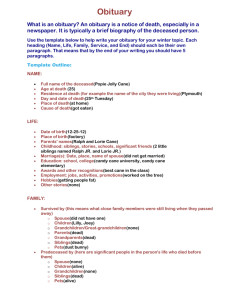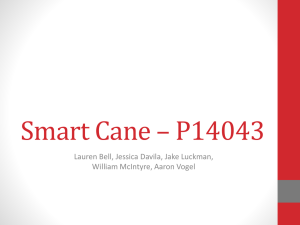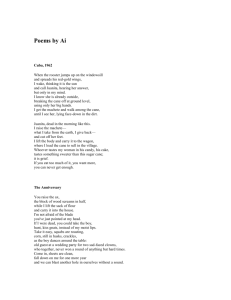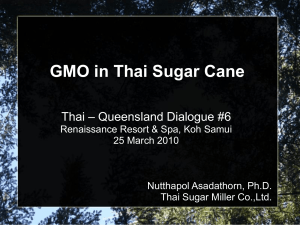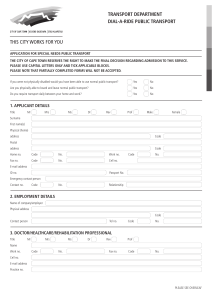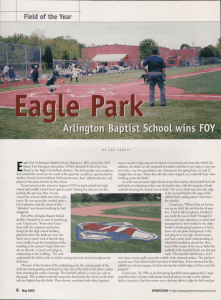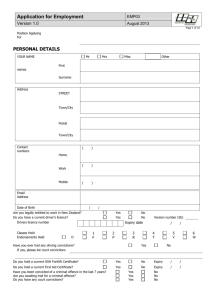IN-FIELD ADVANTAGES OF TRACTOR HAULAGE RIGS: THE MEGATONS EXPERIENCE L.M. Turvey
advertisement
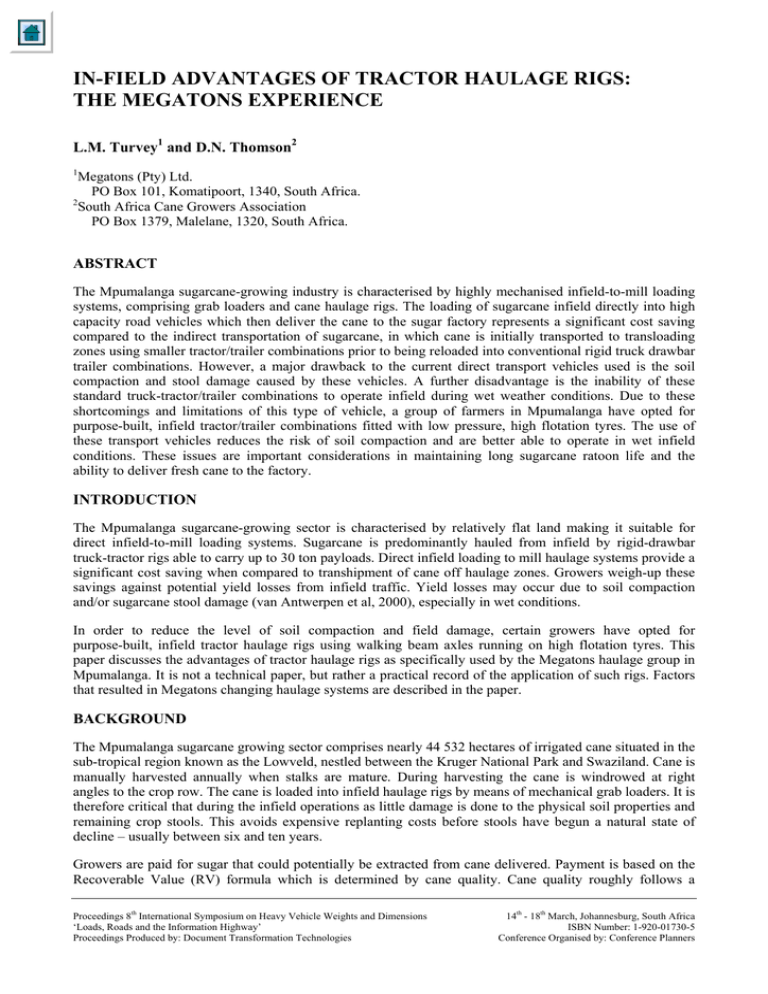
IN-FIELD ADVANTAGES OF TRACTOR HAULAGE RIGS: THE MEGATONS EXPERIENCE L.M. Turvey1 and D.N. Thomson2 1 Megatons (Pty) Ltd. PO Box 101, Komatipoort, 1340, South Africa. 2 South Africa Cane Growers Association PO Box 1379, Malelane, 1320, South Africa. ABSTRACT The Mpumalanga sugarcane-growing industry is characterised by highly mechanised infield-to-mill loading systems, comprising grab loaders and cane haulage rigs. The loading of sugarcane infield directly into high capacity road vehicles which then deliver the cane to the sugar factory represents a significant cost saving compared to the indirect transportation of sugarcane, in which cane is initially transported to transloading zones using smaller tractor/trailer combinations prior to being reloaded into conventional rigid truck drawbar trailer combinations. However, a major drawback to the current direct transport vehicles used is the soil compaction and stool damage caused by these vehicles. A further disadvantage is the inability of these standard truck-tractor/trailer combinations to operate infield during wet weather conditions. Due to these shortcomings and limitations of this type of vehicle, a group of farmers in Mpumalanga have opted for purpose-built, infield tractor/trailer combinations fitted with low pressure, high flotation tyres. The use of these transport vehicles reduces the risk of soil compaction and are better able to operate in wet infield conditions. These issues are important considerations in maintaining long sugarcane ratoon life and the ability to deliver fresh cane to the factory. INTRODUCTION The Mpumalanga sugarcane-growing sector is characterised by relatively flat land making it suitable for direct infield-to-mill loading systems. Sugarcane is predominantly hauled from infield by rigid-drawbar truck-tractor rigs able to carry up to 30 ton payloads. Direct infield loading to mill haulage systems provide a significant cost saving when compared to transhipment of cane off haulage zones. Growers weigh-up these savings against potential yield losses from infield traffic. Yield losses may occur due to soil compaction and/or sugarcane stool damage (van Antwerpen et al, 2000), especially in wet conditions. In order to reduce the level of soil compaction and field damage, certain growers have opted for purpose-built, infield tractor haulage rigs using walking beam axles running on high flotation tyres. This paper discusses the advantages of tractor haulage rigs as specifically used by the Megatons haulage group in Mpumalanga. It is not a technical paper, but rather a practical record of the application of such rigs. Factors that resulted in Megatons changing haulage systems are described in the paper. BACKGROUND The Mpumalanga sugarcane growing sector comprises nearly 44 532 hectares of irrigated cane situated in the sub-tropical region known as the Lowveld, nestled between the Kruger National Park and Swaziland. Cane is manually harvested annually when stalks are mature. During harvesting the cane is windrowed at right angles to the crop row. The cane is loaded into infield haulage rigs by means of mechanical grab loaders. It is therefore critical that during the infield operations as little damage is done to the physical soil properties and remaining crop stools. This avoids expensive replanting costs before stools have begun a natural state of decline – usually between six and ten years. Growers are paid for sugar that could potentially be extracted from cane delivered. Payment is based on the Recoverable Value (RV) formula which is determined by cane quality. Cane quality roughly follows a Proceedings 8th International Symposium on Heavy Vehicle Weights and Dimensions ‘Loads, Roads and the Information Highway’ Proceedings Produced by: Document Transformation Technologies 14th - 18th March, Johannesburg, South Africa ISBN Number: 1-920-01730-5 Conference Organised by: Conference Planners normal curve, tailing at the beginning and end of the milling season and peaking during the drier winter months - known as the RV curve. Due to the shape of the RV curve, growers are required to deliver their cane rateably throughout the milling season for 24 hours a day, seven days a week. It is therefore critical that an infield haulage system is able to work throughout the cane milling season from April to December - especially during the wet periods. SOIL COMPACTION Soil compaction may be defined as the process of soil particles moving closer together as the result of external forces from machinery, falling rain, overburden pressures and shrinkage of soils upon drying (Torres and Rodriguez, 1995). No clear relationship has been established between compaction and yield loss. It has however been documented that compaction reduces soil porosity, root growth and hence irrigation infiltration rates (van Antwerpen et al, 2000). Research conducted by Soil Foodweb Incorporated (2003) shows that increased compaction and damage to fields in wet conditions can kill critical soil organisms thereby reducing the overall health of the soil. Reducing the risk of compaction and infield damage should result in healthier soils and longer ratoons. Tyre pressure is a factor in soil compaction that cannot be ignored. Bailey et al (1991) found that compaction and soil stress increases with tyre inflation pressure. Cane stool damage from infield traffic also needs to be considered. This factor may attribute to greater shortterm yield losses than compaction. MEGATONS CUTTING GROUP Growers have opted to form cutting-groups by pooling their daily allocations. This allows for the pooling of equipment and taking advantage of scale economies through better utilisation of machinery and labour. This is usually done where farmers are more or less in the same geographic area and have similar farming practices. These cutting-groups have the same responsibilities and benefits as an individual grower, but have to deliver a greater daily allocation. Growers are paid individually and are therefore responsible for cane quality and production. Megatons (Pty) Ltd is a group of eight farmers committed to long-term, high quality cane yields with minimal infield damage. Megatons operate to a maximum radius of nearly 25 kilometres around the Komati Mill, with an average lead distance of approximately 11 kilometres. The combined annual tonnage is nearly 225 000 tons of sugarcane for the 2003/04 season. The crop is moved using six 160 kW haulage tractor rigs and loaded infield by three mechanical grab loaders. The current capacity of the machinery is approximately 250 000 tons. Current daily allocation at the mill is approximately 1 100 tons a day which equates to a cut of ten hectors a day. Megatons (Pty) Ltd is also the founding member of a private toll road, providing a shorter route to the Komati Mill. A further incentive for the group to develop low ground pressure rigs within the Road Traffic Act axle mass restrictions is to ensure the long-term viability of the pavement. INFIELD HAULAGE SYSTEMS Description of infield loading systems In most areas of the South African sugar industry, cane is burnt, cut and windrowed or stacked. Generally, cut cane is extracted from fields either by hauling small bundles to a loading zone where it is transhipped onto a haulage rig, or haulage rigs are loaded directly infield. Both methods have pros and cons. In many areas of the sugar industry terrain is the limiting factor. Growers who farm on steeper terrain can only extract cane in small bundles to a loading zone. In Mpumalanga the relatively flat terrain allows haulage rigs to be loaded infield by grab loaders avoiding the costs of transhipment. Infield loading – the Megatons system The Megatons group have fitted high flotation tyres inflated between 0.7 and 0.8 bar on 46 kW three-wheel mechanical grab loaders. The advantage of this configuration is two fold; Firstly, compaction is reduced because of lower tyre pressures, secondly the soft-profile tyres reduce tractability thereby avoiding the push piling of cane which results in cane stool damage. Table 1 compares loading costs for the two different loading systems in Mpumalanga. The rates compared are actual rates charged by Megatons (Pty) Ltd to members and costs charged by other haulage groups who tranship in Mpumalanga for the 2002/03 season. Table 1. Loading cost comparison, 2002/03 deason. Loading Method Loading Cost Difference Tons Hauled Savings MEGATONS In-field – Mill R6.20/ton cane R3.80/ton cane 215 000 R817 000 SURVEY In-field – Zone – Mill R10.00/ton cane Windrowed cane is loaded into two-wheel drive 160kW haulage tractors pulling tandem trailers parallel with the cane rows. These vehicles have a tare mass of approximately 21.6 tons. Each trailer is 9.4 metres long, with a bin size of 7.6 metres, placing the total vehicle length within the 22 metre maximum legal limit – see Figure 1. The vehicles are designed to haul 24-28 ton payloads giving a Gross Combination Mass (GCM) of 45-48 tons. It takes approximately 20 minutes for each vehicle combination to be loaded infield. Walking beam axles are fitted to each trailer. The first semi-trailer, when fully loaded has a weight forward transfer onto the haulage tractor’s hitching point, approximately 60mm ahead of the driving axle, giving the tractor’s driving axle at total mass of about 7.5 tons. This improves the stability of the haulage unit by providing a forward weight transfer onto the tractor’s steering axle. The rear trailer has a weight forward transfer onto the first semi-trailer. The trailers have been designed in such a manner that they can be detached in adverse infield conditions and hauled infield as single units if necessary. The entire combination has a progressive braking system that enables the trailers to begin breaking before the haulage unit, reducing the risk of jackknifing. Figure 1. General vehicle design. Table 2. Load distribution. Tractor D Axle 5640 2300 7170 2340 6960 2328 6895 2340 6820 2327 6961 FW TARE Rig # 1 Rig # 2 Rig # 3 Rig # 4 Average Gross Combination 9288 (Source: Michelin SA, 2001) Semi-Trailer FW RW 7980 9580 10300 9540 10000 9845 10200 9810 10500 9694 10250 Rear Trailer FW RW 7980 10700 12000 7120 7590 8200 8700 8570 10000 8648 9573 TOTAL 52050 43550 46168 48040 47452 19944 18220 47452 TARE 21600 21600 21600 21600 21600 PAYLOAD 30450 21950 24568 26440 25852 Table 2 illustrates the average mass distribution in kilograms of four of the haulage units currently in use as established in research conducted by Michelin SA (2001) for Megatons Pty (Ltd). It must however be noted that the average payload of nearly 26 tons does not comply with current legislation as prescribed by the Road Traffic Act. Haulage tractors have proven they are able to safely haul a gross combination mass of 48 000 kilograms (Gerotek, 2003). Based on the Gerotek (2003) test results, legislation pertaining to haulage tractors is currently under review, which would ‘legalise’ the haulage tractors. The flat-deck, side-tipping trailers are built on walking beam axles. The trailers have a single compartment to ensure maximum payloads and ease of loading. The walking beam axle design allows the trailer to ‘climb’ rather than ‘plough’ through infield humps or ridges with lower drawbar requirements. The walking beam is constructed out of two tubes of unequal length, the leading tube being slightly longer, set at a slight V-angle to each other – see Figure 2. This results in a lower centre of gravity by having the pivotal point lower than the stub-axles. The resulting line of pull is below the stub-axles, but more or less in line with the tractor hitch. As the leading tube is longer than the trailing tube, proportionally it carries less mass and is therefore less likely to get stuck under adverse infield conditions. The tendency would be to pull the front wheel out of trouble rather than force it down thus paving the way for the rear tyre. This makes the whole rig easier to handle under difficult conditions when compared to leaf-spring suspensions. An additional advantage of the walking beam is the pivotal point ensures that the load mass is evenly distributed between all wheels – even while traversing obstacles. The suspension thus has minimum impact on cane stools, even when fields are wet or if rows need to be traversed. Figure 2. Walking beam design. Throughout the haulage configuration, the widest possible tyres have been used. This ensures the widest and longest possible footprint. The rear tractor tyres are inflated to 1.7 bar, while the front tyres are inflated to 1.65 bar. The trailer tyres are inflated to 3.5 bar. Table 3 summarises the tyre configurations and pressures, as well as estimated axle masses. Table 3. Tyre configuration summary. Position Type Steering Axle Radial HFT Driving Axle Radial HFT Semi- Trailer Radial HFT Rear Trailer Radial HFT HFT = High flotation tyre Size 385/65R 22.5 650/65R 38 XM 108 550/60R 22.5 550/60R 22.5 Inflation Pressure 1.6 Bar 1.5 Bar 3.5 Bar 3.5 Bar Axle Mass 2.7 tons 7.5 tons 18 tons 18 tons In comparison, standard rigid-truck/drawbar combinations in Mpumalanga do not utilise the same supersingle tyre configurations. As a result, the narrower single tyres used cause greater infield damage and rutting – especially in wet conditions. Figure 3 illustrates the damage caused to fields when operating this type of vehicle in wet fields. In such cases, infield damage can cause yield losses of up to 20 tons per hectare (Gillespie, 2003). Figure 3. Infield damage caused by standard truck-tractor rigs. Figure 4. Infield damage caused by standard tyres. One of the main causes of infield damage by standard rigid-truck/drawbar trailer combinations is the loaded mass on the steering axle, which is normally about 7 tons. Figure 4 illustrates the inability of this type of vehicle to operate in adverse infield conditions. Also note how the vehicle has turned across the cane rows in order to try and improve traction. This is exactly the situation the Megatons group wants to avoid. It must however be noted that standard rigid truck/drawbar trailer rigs have their place in the Mpumalanga sugar industry. Due to slower on-road speeds, tractor haulage rigs have a confined operating radius of approximately 25 kilometres after which rigid truck/drawbar trailer combinations have a definite economic advantage. The owning and operating of haulage equipment by Megatons does not offer any significant transport savings to its members presently when compared to rates offered by commercial hauliers. However, once capital has been paid off, significant cost savings will accrue to members. Currently, the most significant advantage of establishing Megatons is the ability of the members to take greater control over their harvesting and hauling operations thereby ensuring the delivery of fresh cane with minimal infield damage. The benefits to the Megatons group of using purpose built haulage tractors on high flotation tyres can be summarised as follows: • Risk of compaction and cane stool damage is minimised. This increases the probability of older and healthier ratoons and soils. Currently, certain members of the Megatons group have extended ratoon ages from an average of six years to nearly ten years before needing to replant. • The need to rip the interrow in order to reduce the effects of compaction is reduced. • Improved water penetration and thus improved irrigation efficiency. • High flotation tyres give a greater footprint, resulting in less rutting and therefore less stool displacement and water ponding which increases soil salinity. • If needed, cane rows can be traversed with little or no stool damage. • Ability to extract cane in wet weather conditions within reason, thus ensuring rateable delivery throughout the milling season. CONCLUSION Infield-to-mill haulage is set to predominate the Mpumalanga sugar industry for the foreseeable future. The costs of infield damage to soil and cane stools are weighed up against the savings through avoiding double handling. The Megatons group have designed their entire loading and hauling system to minimise the risk of infield damage and ensure efficient delivery to the mill. By making use of walking beam axles and high flotation tyres, soil displacement and stool damage is minimised, enabling the rigs to operate in all, but the wettest of conditions. By attempting to remain within legislated axle mass limitations, the group also ensures the long-term viability of their private toll road. The system described here may not be the most efficient on-road transport system. However, when considering infield performance, the system ensures the group is able to deliver a quality product rateably to the Komati sugar mill. REFERENCES 1. Bailey, AC; Raper, RL and Burt, EC (1991). The effects of tire inflation pressure on soil stresses. Paper presented to American Society of Agricultural Engineers, Albuquerque, New Mexico. 2. Gerotek (2003). Test Report: Haulage Tractor Test 72 CM 2264-04. 3. Gillespie, G (2003). Personal Communication. Cane Quality Officer, Transvaal Sugar Limited. 4. Michelin SA (2001). Tyre report for Megatons Pty (Ltd). 5. Soil Foodweb Incorporated (2003). Internet article at www.soilfoodweb.com 6. Torres, JS and Rodrigues LA (1995). Soil compaction management for sugarcane. Proc Int Soc Sug Cane Technol 22: 193-202. 7. Van Antwerpen, R; Meyer, JH and Meyer, E (2000). Proc of S Afr Sug Technol Ass, 74:
